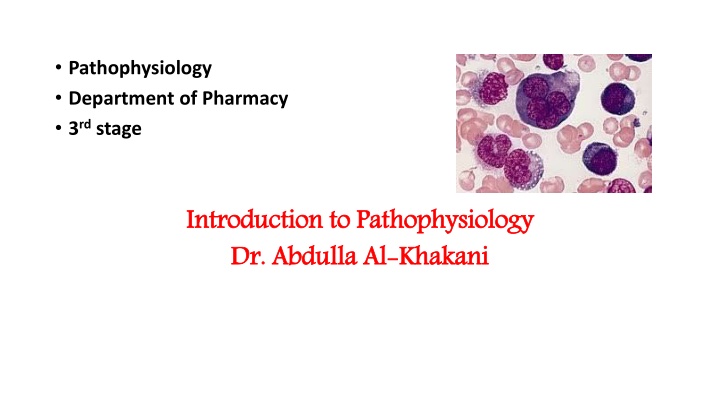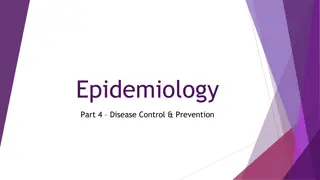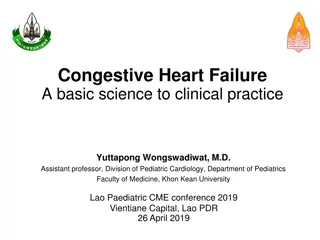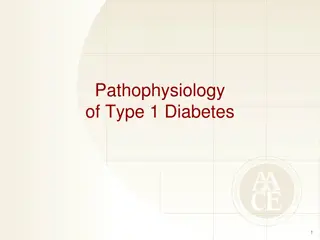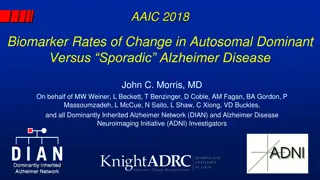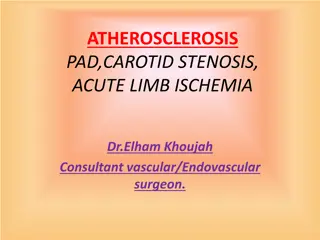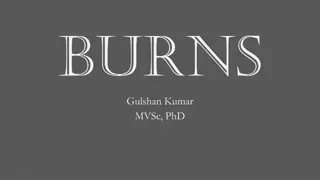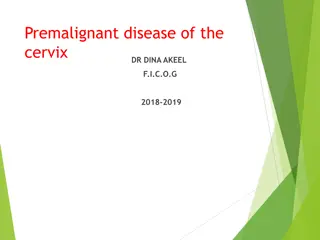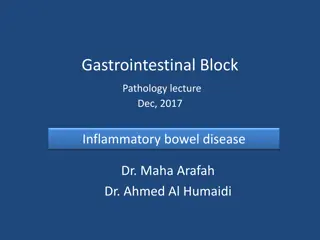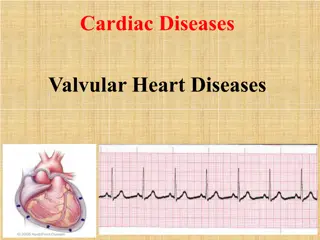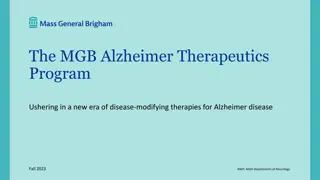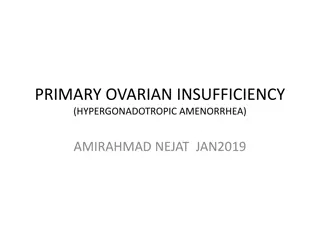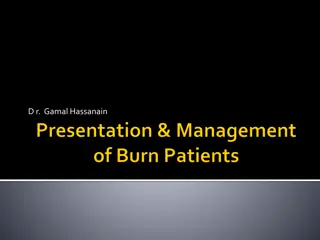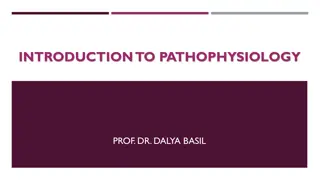Introduction to Pathophysiology: Understanding Disease Processes
Pathophysiology delves into the altered physiological processes associated with disease, focusing on how the body responds to injury and fights off illnesses. It encompasses the study of pathology and physiology, helping professionals identify disease origins, causes, and progression. Clinical pathology, a medical specialty, uses laboratory analysis to diagnose diseases based on bodily fluid and tissue examinations.
Download Presentation

Please find below an Image/Link to download the presentation.
The content on the website is provided AS IS for your information and personal use only. It may not be sold, licensed, or shared on other websites without obtaining consent from the author.If you encounter any issues during the download, it is possible that the publisher has removed the file from their server.
You are allowed to download the files provided on this website for personal or commercial use, subject to the condition that they are used lawfully. All files are the property of their respective owners.
The content on the website is provided AS IS for your information and personal use only. It may not be sold, licensed, or shared on other websites without obtaining consent from the author.
E N D
Presentation Transcript
Pathophysiology Department of Pharmacy 3rdstage Introduction to Pathophysiology Dr. Abdulla Introduction to Pathophysiology Dr. Abdulla Al Al- -Khakani Khakani
Introduction to Pathophysiology Introduction to Pathophysiology Objectives In this session we will focus on; Define pathology and Pathophysiology Discuss Briefly discuss each of the five components of the disease process which include; Prevalence, etiology, pathogenesis, clinical manifestation, and outcomes Objectives In this session we will focus on; Define pathology and Pathophysiology Discuss the basic concepts of disease and its development. Briefly discuss each of the five components of the disease process which include; Prevalence, etiology, pathogenesis, clinical manifestation, and outcomes the basic concepts of disease and its development.
Pathology Pathology The suffering ; and logia means the study of Pathology is a branch of medical science primarily cause, origin, and nature of the disease. Body tissue, blood, and other bodily fluids are analyzed to assist medical practitioners in identifying the cause and severity of disease and to monitor treatment. The word pathology is from Greek, pathos, which means feeling, or suffering ; and logia means the study of Pathology is a branch of medical science primarily concering cause, origin, and nature of the disease. Body tissue, blood, and other bodily fluids are analyzed to assist medical practitioners in identifying the cause and severity of disease and to monitor treatment. word pathology is from Greek, pathos, which means feeling, or concering the the
Clinical pathology Clinical pathology Is based on the laboratory analysis of bodily fluids such as blood and urine, as well as tissues, using the tools of biochemistry, clinical microbiology, hematology, immunology, and molecular pathology e.g. PCR (polymerase chain reaction). Is a medical specialty that is concerned with the diagnosis of disease based on the laboratory analysis of bodily fluids such as blood and urine, as well as tissues, using the tools of biochemistry, clinical microbiology, hematology, immunology, and molecular pathology e.g. PCR (polymerase chain reaction). a medical specialty that is concerned with the diagnosis of disease
Pathophysiology Pathophysiology The health. The term combines the words The pathophysiology health. The term combines the words pathology pathophysiology may be defined as the physiology of altered may be defined as the physiology of altered pathology and and physiology physiology. . Basically, Pathophysiology is the disordered physiological processes associated with injury or disease (the immune system). This area studies how the body reacts to injury or fights off disease Basically, Pathophysiology is the disordered physiological processes associated with injury or disease (the immune system). This area studies how the body reacts to injury or fights off disease. . The functional changes associated with or resulting from disease or injury e.g. inflammation in response to an injury. The functional changes associated with or resulting from disease or injury e.g. inflammation in response to an injury.
Disease Disease The something is wrong with bodily function The term disease literally means without ease (uneasiness), when something is wrong with bodily function. . term disease literally means without ease (uneasiness), when The term disease broadly refers to any condition that impairs the normal functioning of the body The term disease broadly refers to any condition that impairs the normal functioning of the body. . Diseases are associated with the homeostatic processes. Diseases are associated with the dysfunctioning homeostatic processes. dysfunctioning of the body s normal of the body s normal
Pathogenesis Pathogenesis The word Pathogenesis genesis (creation The word Pathogenesis comes from the Greek pathos (disease) and genesis (creation). ). comes from the Greek pathos (disease) and The Pathogenesis of the disease is the biological mechanism that leads to the disease state. The term can also describe the origin and development of the disease and whether it is acute, chronic, or recurrent. The Pathogenesis of the disease is the biological mechanism that leads to the disease state. The term can also describe the origin and development of the disease and whether it is acute, chronic, or recurrent.
Factors affecting the pathogen Factors affecting the pathogen 1 1- - Mechanism cellular metabolism, and render the cell dysfunctional. Because of the accumulation of pathogenic substances and toxic production 2 2- - Infectivity host. 3 3- - Pathogenicity speed of production, the extent of tissue damage, and the production of toxin. 4 4- - Virulence number of microorganisms of toxin required to kill the host. Mechanism of action: pathogens directly damage cells, interfere with cellular metabolism, and render the cell dysfunctional. Because of the accumulation of pathogenic substances and toxic production. . Infectivity: the ability of the pathogen to invade and multiply in the host. Pathogenicity: the ability of an agent to produce disease depend on its speed of production, the extent of tissue damage, and the production of toxin. Virulence: the potency of a pathogen measured in terms of the number of microorganisms of toxin required to kill the host. of action: pathogens directly damage cells, interfere with : the ability of the pathogen to invade and multiply in the : the ability of an agent to produce disease depend on its : the potency of a pathogen measured in terms of the
Factors affecting the pathogen Factors affecting the pathogen 5 5- - Immunogenicity: the ability of pathogens to induce an immune response. 6 6- - Toxigenicity such as Hemolysin the product of streptococci and staphylococci. 7 7- - Portal of entry: the route by which a pathogenic organism infects the host: direct contact, inhalation, ingestion, or bite of an animal or insect. The spread of infection is facilitated by the ability of pathogens to spread through the lymph and blood into tissue and organ, where they multiply and cause disease Immunogenicity: the ability of pathogens to induce an immune response. Toxigenicity: a factor important in determining a pathogen s virulence, such as hemolysin Hemolysin destroy erythrocyte, and leucocidin destroys leucocytes, both are the product of streptococci and staphylococci. Portal of entry: the route by which a pathogenic organism infects the host: direct contact, inhalation, ingestion, or bite of an animal or insect. The spread of infection is facilitated by the ability of pathogens to spread through the lymph and blood into tissue and organ, where they multiply and cause disease : a factor important in determining a pathogen s virulence, hemolysin, , leucosidine destroy erythrocyte, and leucocidin destroys leucocytes, both are leucosidine, and other exotoxins, and endotoxins. , and other exotoxins, and endotoxins.
Natural History of the Disease Natural History of the Disease The individual from its pathological onset to its eventual resolution through complete recovery, disability, or death in the absence of intervention. It has four stages 1 1- - stage of susceptibility. 2 2- - stage of subclinical disease. 3 3- - stage of clinical disease. 4 4- - stage of recovery, or disability or death. The natural history of disease is the course a disease takes place in an individual from its pathological onset to its eventual resolution through complete recovery, disability, or death in the absence of intervention. It has four stages stage of susceptibility. stage of subclinical disease. stage of clinical disease. stage of recovery, or disability or death. natural history of disease is the course a disease takes place in an
Prevalence Prevalence In cases of the risk factor in the population at a given time or the total number of cases in the population, divided by the number of individuals in the population. Prevalence In a statistical population is defined as the total number of cases of the risk factor in the population at a given time or the total number of cases in the population, divided by the number of individuals in the population. Prevalence = a/a + ? a statistical population is defined as the total number of
Etiology Etiology Etiology The word is derived from the Greek, giving a reason for philosophical to the reasons behind the way that things act. The Among the recognized etiologic agents are biologic agents (e.g., bacteria, viruses), physical forces (e.g., trauma, burns, radiation), chemical agents (e.g., poisons, alcohol), and nutritional excesses or deficits. Etiology is the study of causation or The word is derived from the Greek, aitiologia giving a reason for Used philosophical theories, where it is to the study of why things occur or the reasons behind the way that things act. The causes of disease are known as Among the recognized etiologic agents are biologic agents (e.g., bacteria, viruses), physical forces (e.g., trauma, burns, radiation), chemical agents (e.g., poisons, alcohol), and nutritional excesses or deficits. is the study of causation or origination origination aitiologia, , Used in medical and theories, where it is used to refer the study of why things occur or even in medical and used to refer even causes of disease are known as etiologic factors etiologic factors. .
Etiology Etiology At the molecular level, it is important to distinguish between abnormal molecules and molecules that cause disease. At the molecular level, it is important to distinguish between abnormal molecules and molecules that cause disease. This is true of diseases such as cystic fibrosis, sickle cell anemia, and familial hypercholesterolemia, in which the genetic abnormality of single amino acid, transporter molecule, or receptor protein produces widespread effects on health. This is true of diseases such as cystic fibrosis, sickle cell anemia, and familial hypercholesterolemia, in which the genetic abnormality of single amino acid, transporter molecule, or receptor protein produces widespread effects on health.
Clinical manifestation Diseases can manifest in a number of ways. Sometimes make it evident that the person is sick. In during examination for other purposes or after the advanced. Signs functional changes that accompany a disease. A A symptom a disorder, whereas a observer. Clinical manifestation Diseases can manifest in a number of ways. Sometimes the condition produces manifestations, such as fever, that make it evident that the person is sick. In other cases, the condition is silent at the onset and is detected during examination for other purposes or after the disease is advanced. Signs and functional changes that accompany a disease. symptom is a subjective complaint that is noted by the person with a disorder, whereas a sign observer. the condition produces manifestations, such as fever, that other cases, the condition is silent at the onset and is detected disease is far far and symptoms symptoms are terms used to describe are terms used to describe the structural the structural and and is a subjective complaint that is noted by the person with sign is a manifestation that is noted by an is a manifestation that is noted by an
Signs Signs and and symptoms symptoms Pain, difficulty in breathing, and dizziness are symptoms of a disease. An elevated temperature, a swollen extremity, and changes in pupil size are objective signs that can be observed by someone other than the person with the disease. Signs and symptoms may be related to the primary disorder or they may represent the body s attempt to compensate for the altered function caused by the pathologic condition.
Many pathologic states are not observed directlyone cannot see a sick heart or a failing kidney. Instead, what can be observed is the body s attempt to compensate for changes in function brought about by the disease, such as the tachycardia that accompanies blood loss or the increased respiratory rate that occurs with pneumonia. A A syndrome fatigue syndrome) that are characteristic of a specific disease state. Complications outcomes from treatment. Sequelae disease. syndrome is a compilation of signs and symptoms (e.g., chronic Complications are possible adverse extensions of a disease or Sequelae are lesions or impairments that follow or are caused by a
Outcome Outcome The outcome which may be any of the following form Complete recovery Recovery with disability Death The consequence of the disease or the end of the disease is known as the outcome which may be any of the following form Complete recovery Recovery with disability Death consequence of the disease or the end of the disease is known as the
Morphology Morphology Morphology Morphologic changes are concerned with both the gross anatomic and microscopic changes that are characteristic of a disease. Histology tissues. The most common method used in the study of tissues is the preparation of histologic sections thin, translucent sections of human tissues and organs that can be examined with the aid of a microscope. Histologic sections play an important role in the diagnosis of many types of cancer. A A lesion tissue. Descriptions of lesion size and characteristics often can be obtained through the use of radiographs, ultrasonography, and other imaging methods. Lesions also may be sampled by biopsy and the tissue samples subjected to histologic study. Morphology refers to the fundamental structure or form of cells or tissues. Histology deals with the study of the cells and extracellular matrix of body lesion represents a pathologic or traumatic discontinuity of a body organ or
Diagnosis Diagnosis A diagnosis is a designation as to the nature or cause of a health problem (e.g., bacterial pneumonia or hemorrhagic stroke). The diagnostic process usually requires a careful history and physical examination. The history is used to obtain a person s account of his or her symptoms and their progression, and the factors that contribute to a diagnosis. The physical examination is done to observe for signs of altered body structure or function. The development of a diagnosis involves weighing competing possibilities and selecting the most likely one from among the conditions that might be responsible for the person s clinical presentation.
Diagnosis Diagnosis The clinical probability of a given disease in a person of a given age, gender, race, lifestyle, and locality often is influential in arriving at a presumptive diagnosis. Laboratory tests, radiologic studies, computed tomography (CT) scans, and other tests often are used to confirm a diagnosis. An important factor when interpreting diagnostic test results is the determination of whether they are normal or abnormal.
